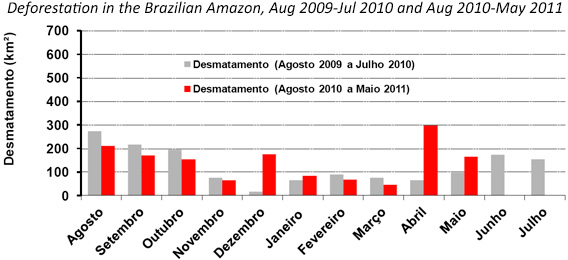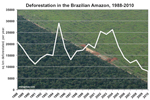
Deforestation in the Brazilian Amazon from August 2009-May 2011.
Deforestation in the Brazilian Amazon continued to rise as Brazil’s Congress weighed a bill that would weaken the country’s Forest Code, according to new analysis by Imazon.
Imazon’s near-real time deforestation tracking system found that 165 square kilometers (103 square miles) of forest was cleared last month, a 72 percent rise over May 2010. Accumulated deforestation in the period from August 2010 to May 2011 amounted to 1,435 sq km (1090 sq km), an increase of 24 percent over the same time-frame a year earlier. Deforestation in Brazil is typically measured on a calendar year ending in July, when cloud cover in the region is at a low point. Deforestation usually peaks in the Brazil Amazon during the dry season which runs from July through October.
While the increase is significant, deforestation in the region is still well below what it was five years ago. Deforestation has steadily declined since 2004 due to a several factors including macroeconomic trends, improved law enforcement, new protected areas, pressure from NGOs, and private-sector initiatives. But environmentalists and scientists fear that proposed changes to Brazil’s Forest Code, which requires landholders in the Amazon to maintain 80 percent forest cover on their lands, could trigger a reversal in deforestation rates. Scientists expect the impact of forest loss and degradation to be amplified by climate change, which is thought to have contributed to the two worst droughts on record, both of which occurred since 2005.

Degradation in the Brazilian Amazon from August 2009-May 2011.
The analysis by Imazon suggests that the Forest Code debate may be a factor in rising deforestation. It found a 363 percent increase in forest degradation — logging and burning of forest that typically precedes deforestation — over the past 10 months, reaching 6,081 sq km. Most of the degradation occurred in major agricultural states: Mato Grosso (42 percent of degradation in May), Para (27 percent), and Rondônia (22 percent). The majority of deforestation also took place in these states: 39 percent in Pará, 25 percent in Mato Grosso, and 21 percent in Rondônia.
More tellingly, two-thirds of clearing occurred on private lands, which are most likely to benefit from changes in the Forest Code. Private landowners — particularly agroindustrial interests — have been pushing Forest Code reform, while small landowners and indigenous groups have generally opposed changes. Accordingly, deforestation over the past 10 months in indigenous territories and areas of agrarian reform (usually small-holder zones) amounted to only 12 percent and 1 percent, respectively. 22 percent of deforestation in May 20111 occurred in conservation areas.
Deforestation in May was highest in the municipality of Altamira, Para, where the controversial Belo Monte dam is to be constructed. Critics say the project will drive deforestation in surrounding areas as well as inundating large areas of forest and displacing thousands of indigenous people. Altamira accounted for 13 percent of total deforestation. It was followed by Porto Velho, Rondonia (8 percent), which serves as a key hub for the newly paved Trans-Oceanic Highway that links the heart of the Amazon to Peruvian ports. The highway will facilitate shipping of agricultural and timber products from the Amazon to China.

Deforestation in May 2011.
Imazon also estimated emissions from deforestation. It figures clearing in May committed 10.3 million tons of carbon dioxide emissions to the atmosphere, an amount roughly equivalent to the annual emissions of Mongolia or the state of Rhode Island.
Deforestation in the Brazilian Amazon is typically driven by industrial agriculture and land speculation. More than 70 percent of deforested land ends up as cattle pasture. High commodity prices typically create incentives for deforestation.
The Amazon rainforest is the world’s largest tropical rainforest. More than 60 percent of it lies within the borders of Brazil.

Until March 2011, the trend in the Brazilian Amazon had been very positive, with annual deforestation falling nearly 80 percent since 2004.
Related articles
Revised Forest Code may cost Brazil climate commitments

(06/14/2011) The proposed revision of Brazil’s Forest Code could prevent the country from meeting its lower emissions target and is unlikely to ease rural poverty, concludes a new study by the Brazil-based Institute of Applied Economic Research (IPEA).
Majority of Brazilians reject changes in Amazon Forest Code
(06/11/2011) The vast majority of Brazilians reject a bill that would weaken Brazil’s Forest Code, according to a new poll commissioned by green groups.
Rash of murders threatens to silence environmental and social activism in Brazil

(06/10/2011) Authorities in Brazil have sent an elite police force consisting of 60 officers to offer protection to environmental activists in the Amazon after a series of killings, reports the Associated Press. The move comes 10 days after Brazil’s Vice President Michel Temer announced the creation of a working group on Amazon violence following the assassinations of three activists in the region in late May. The Brazilian Amazon is no stranger to systemic violence against environmental activists, yet the response from the federal government in the past two weeks is the most significant to date.

(06/03/2011) As an American I know a lot about shame — the U.S. government and American companies have wrought appalling amounts of damage the world over. But as an admirer of Brazil’s recent progress toward an economy that recognizes the contributions of culture and the environment, this week’s decision to move forward on the Belo Monte dam came as a shock. Belo Monte undermines Brazil’s standing as a global leader on the environment. Recent gains in demarcating indigenous lands, reducing deforestation, developing Earth monitoring technologies, and enforcing environmental laws look more tenuous with a project that runs over indigenous rights and the environment.
Assassinations of environmentalists continue in Brazil’s Amazon, deforestation rises

(05/28/2011) A community leader in the Brazilian Amazon was slain Friday just three days after two environmentalists were killed in a neighboring state, reports Reuters. Adelino “Dinho” Ramos, the president of the Movimento Camponeses Corumbiara e da Associação dos Camponeses do Amazonas, a small farmers association, was gunned down front of his family Friday morning in Rondônia. Brazil’s Special Secretariat for Human Rights, an office of the president, said it was unclear who killed Ramos, who had received death threats from loggers.
Amnesty for illegal rainforest loggers moves forward in Brazil

(05/25/2011) A controversial bill environmentalists say could increase deforestation in the Amazon rainforest moved a step forward to becoming law in Brazil after winning approval in Brazil’s lower house of Congress. The measure, which has been hotly debated for months, next goes to the Senate where it is expected to pass, before heading to President Dilma Rousseff, who has vowed to veto any bill that grants amnesty for illegal deforestation. The bill includes such a measure, although it could be subject to change before a final decision by the president. The bill aims to reform Brazil’s Forest Code, which requires landowners in the Amazon rainforest to maintain 80 percent of their holdings as forest.
Killing in the name of deforestation: Amazon activist and wife assassinated
(05/24/2011) José Cláudio Ribeiro da Silva and his wife, Maria do Espírito Santo da Silva, were gunned down last night in an ambush near their home in the Brazilian state of Pará. Da Silva was known as a community leader and an outspoken critic of deforestation in the region. Police believe the da Silvas were killed by hired assassins because both victims had an ear cut off, which is a common token for hired gunmen to prove their victims had been slain, according to local police investigator, Marcos Augusto Cruz, who spoke to Al Jazeera. Suspicion immediately fell on illegal loggers linked to the charcoal trade that supplies pig iron smelters in the region.
Brazil’s new cabinet-level post in response to surge in deforestation
(05/21/2011) Prompted by a near sixfold increase in Amazon rainforest clearing over the past year, the Brazilian government will form a cabinet post to monitor and respond to deforestation.
Climate change and deforestation pose risk to Amazon rainforest

(05/20/2011) Deforestation and climate change will likely decimate much of the Amazon rainforest, says a new study by Brazil’s National Institute for Space Research (INPE) and the UK’s Met Office Hadley Centre. Climate change and widespread deforestation is expected to cause warmer and drier conditions overall, reducing the resistance of the rainforest ecosystem to natural and human-caused stressors while increasing the frequency of extreme rainfall events and droughts by the end of this century. While climate models show that higher temperatures resulting from global climate change will threaten the resilience of the Amazon, current deforestation is an immediate concern to the rainforest ecosystem and is likely driving regional changes in climate.
Brazil confirms big jump in Amazon deforestation

(05/18/2011) New data from the Brazilian government seems to confirm environmentalists’ fears that farmers and ranchers are clearing rainforest in anticipation of a weakening of the country’s rules governing forest protection. Wednesday, Brazil’s National Space Research Agency (INPE) announced a sharp rise in deforestation in March and April relative to the same period last year. INPE’s rapid deforestation detection system (DETER) recorded 593 square kilometers of forest clearing during the past two months, a 473 percent increase over the 103.5 sq km chopped down from March-April 2010.
Huge surge in Amazon deforestation
(05/17/2011) Analysis by Imazon, a research institute, has confirmed a huge surge in deforestation in a critical part of the Brazilian Amazon.







